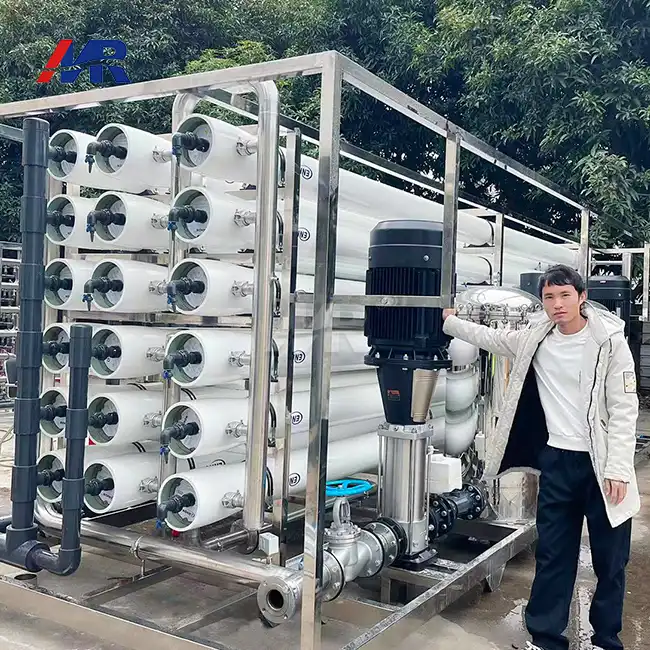Centrifugal vs. Positive Displacement Pumps for RO Systems
When it comes to selecting pumps for reverse osmosis systems, two main types are commonly used: centrifugal pumps and positive displacement pumps. Each has its own advantages and is suited for different applications within the reverse osmosis process.
Centrifugal Pumps in RO Applications
Centrifugal pumps are widely used in reverse osmosis plants due to their versatility and efficiency. These pumps operate by converting rotational kinetic energy into hydrodynamic energy, creating flow and pressure. They are particularly well-suited for high-flow, low-pressure applications, making them ideal for feed water supply and interstage boosting in multi-stage RO systems.
Advantages of centrifugal pumps include:
- High flow rates
- Smooth, continuous flow
- Lower initial cost
- Compact design
- Lower maintenance requirements
Positive Displacement Pumps in RO Systems
Positive displacement pumps, on the other hand, excel in high-pressure, low-flow applications. These pumps work by trapping a fixed volume of fluid and forcing it into the discharge pipe. In reverse osmosis systems, positive displacement pumps are often used for the high-pressure feed pump that drives water through the RO membranes.
Benefits of positive displacement pumps include:
- Ability to generate high pressure
- Consistent flow rate regardless of pressure changes
- Higher efficiency at lower flow rates
- Better suited for viscous fluids
The choice between centrifugal and positive displacement pumps depends on the specific requirements of your reverse osmosis system, including flow rate, pressure needs, and the characteristics of the feed water. In many cases, a combination of both pump types may be used at different stages of the RO process to optimize performance.
Energy-Efficient Pump Designs for Large-Scale BWRO Plants
Energy efficiency is a critical consideration when selecting pumps for large-scale BWRO plants. With energy costs often representing a significant portion of operational expenses, choosing pumps that minimize power consumption while maintaining performance is essential for the long-term sustainability of the reverse osmosis system.
High-Efficiency Pump Technologies
Several innovative pump technologies have been developed to enhance energy efficiency in reverse osmosis applications:
- Variable Frequency Drives (VFDs): These allow pumps to operate at varying speeds, matching the system's demand and reducing energy waste.
- Advanced Impeller Designs: Computational fluid dynamics has led to the development of impeller shapes that maximize efficiency and reduce turbulence.
- Low-Friction Materials: The use of advanced materials in pump construction can reduce internal friction and improve overall efficiency.
- Energy Recovery Devices (ERDs): While not pumps themselves, ERDs work in conjunction with pumps to recapture energy from the high-pressure concentrate stream, significantly reducing the overall energy requirements of the RO system.
Optimizing Pump Selection for Energy Efficiency
When selecting pumps for a large-scale BWRO plant, consider the following factors to maximize energy efficiency:
- System Curve Analysis: Conduct a thorough analysis of the system curve to ensure the pump operates at its best efficiency point (BEP) for the majority of its runtime.
- Proper Sizing: Avoid oversizing pumps, as this can lead to unnecessary energy consumption. Choose a pump that closely matches the system's requirements.
- Pump Efficiency Curves: Compare efficiency curves of different pump models to select the one that offers the highest efficiency across the expected operating range.
- Life Cycle Cost Analysis: Consider the total cost of ownership, including initial investment, energy consumption, and maintenance costs, when making your selection.
By focusing on energy-efficient pump designs and careful selection, operators of large-scale BWRO plants can significantly reduce their energy footprint and operational costs while maintaining high-quality water production.
Avoiding Cavitation in High-Pressure RO System Pumps
Cavitation is a significant concern in high-pressure pumps used in reverse osmosis systems. This phenomenon occurs when the local pressure in the pump falls below the vapor pressure of the liquid, causing the formation and collapse of vapor bubbles. Cavitation can lead to severe damage to pump components, reduced efficiency, and increased maintenance costs.
Understanding Cavitation in RO Pumps
In reverse osmosis applications, cavitation is particularly problematic due to the high pressures involved. The rapid formation and collapse of vapor bubbles can cause:
- Erosion of pump impellers and casings
- Vibration and noise
- Reduced pump performance
- Shortened pump lifespan
Strategies to Prevent Cavitation
To avoid cavitation in high-pressure RO system pumps, consider implementing the following strategies:
- Proper Pump Selection: Choose pumps designed to handle the specific pressure and flow requirements of your RO system.
- Adequate Net Positive Suction Head (NPSH): Ensure that the available NPSH exceeds the required NPSH of the pump at all operating conditions.
- Suction Line Design: Minimize pressure drops in the suction line by using appropriately sized pipes and reducing the number of fittings and bends.
- Installation Considerations: Properly align and install pumps to minimize stress and vibration.
- Operating Parameters: Maintain proper fluid temperatures and avoid operating pumps outside their designed range.
- Regular Maintenance: Conduct routine inspections and maintenance to detect early signs of cavitation and address them promptly.
By implementing these strategies and carefully selecting pumps that are resistant to cavitation, operators can ensure the longevity and reliability of their high-pressure RO system pumps, maintaining optimal performance and minimizing downtime.
Conclusion
Selecting the right pumps for reverse osmosis equipment is a critical decision that impacts the efficiency, reliability, and cost-effectiveness of your water treatment system. By considering the specific needs of your application, focusing on energy efficiency, and implementing strategies to prevent cavitation, you can optimize your RO system's performance and longevity.
At Guangdong Morui Environmental Technology Co., Ltd., we understand the complexities of pump selection for reverse osmosis plants. Our team of experts is dedicated to helping you choose the ideal pumps for your specific needs, whether you're in the manufacturing, food and beverage, pharmaceutical, or municipal water treatment industries. We offer comprehensive solutions, including high-quality reverse osmosis systems, energy-efficient pumps, and expert installation and commissioning services.
Don't let pump selection challenges hinder your water treatment goals. Contact us today at benson@guangdongmorui.com to discuss your reverse osmosis equipment needs and discover how our innovative solutions can help you achieve optimal performance and efficiency in your water treatment processes.
References
1. Johnson, M. (2022). Advanced Pump Selection Strategies for Reverse Osmosis Systems. Water Technology Magazine, 45(3), 78-85.
2. Smith, A., & Brown, R. (2021). Energy Optimization in Large-Scale BWRO Plants: A Comprehensive Study. Desalination Journal, 512, 115-128.
3. Lee, K., et al. (2023). Cavitation Prevention Techniques in High-Pressure RO Pumps. Journal of Membrane Science, 650, 120-135.
4. García-Rodríguez, L. (2020). Pump Technology Advancements for Seawater Reverse Osmosis Plants. Desalination and Water Treatment, 178, 355-370.
5. Wang, Y., & Zhang, H. (2022). Comparative Analysis of Centrifugal and Positive Displacement Pumps in RO Applications. Water Research, 205, 117-131.
6. Thompson, R. (2021). Life Cycle Cost Analysis of Pumps in Reverse Osmosis Systems. Journal of Water Process Engineering, 40, 101-112.

_1745823981883.webp)


